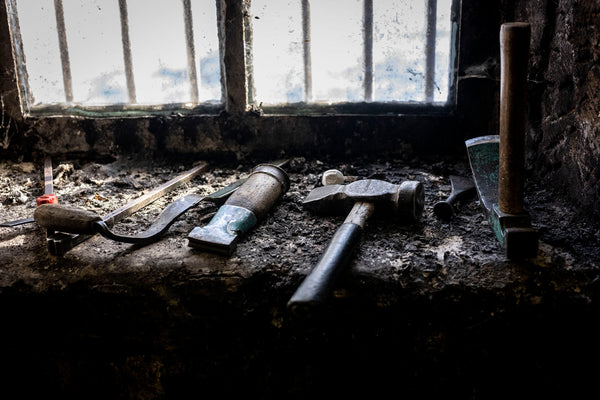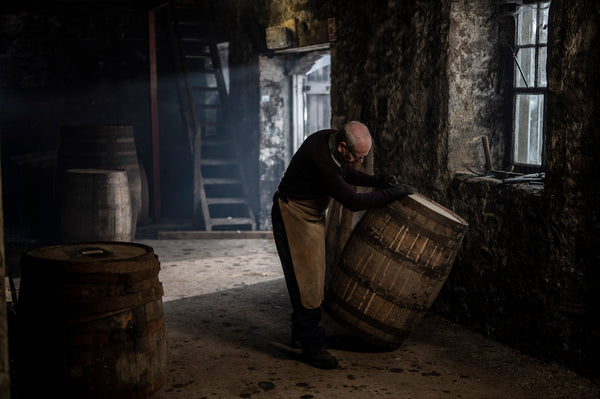The Cooper: the guardian charged with the foundations of flavour in the craft of cask creation.
The wood policy behind a whisky producer is perhaps the single most important aspect of whisky making. Often the casks selected for a lengthy slumber will decide the fate and palate of the new make within – and the choice made by the craftsmen known coopers could be the difference between a costly mistake and a sensory celebration.
One such individual tasked with the custody and care of the House of Hazelwood private stocks is that of Ian McDonald. A native of Dufftown, the House of Hazelwood’s spiritual home, Ian is one of the most experienced and respected coopers of the industry today. Beginning his training as a cooper at the age of just 15 in the year of 1969, over the years, Ian has amassed a wealth of experience, eventually progressing to the role of head cooper in 2008, before retiring after half a century in 2019.
Join us, as Ian kindly imparts his invaluable experiences over the years as a head cooper.
How did it all begin?
It began 1969. I was 15 years old, and I came straight to the distillery, and the Gordon family after leaving school.
Did you always want to be a cooper?
My best subjects at school were woodwork and metalwork. I always enjoyed the technical side of school. When I was a young boy there used to be a couple of cooperages in the town, so I used to go down and watch the coopers making and repairing the barrels and I thought to myself that would be quite good. It looked like a good craft to be in.
Do you have an idea of how many casks you’ve raised over the years?
You’re not the first to ask – it’s a question I get a lot. In my career, I think it’s been about a quarter of a million casks I’ve repaired. So, 250,000. When you think of the casks that are laid down here in Dufftown, there’s over a million casks on site, so I reckon a quarter of these belong to me!
How do you become a cooper?
I started with an apprenticeship. The apprenticeship now is four years, but when I studied, it was five years. During the time that I started studying, they started doing what’s called a trade test - they had somebody from the cooperage federation and your manager come out and gave you a test. As part of the test, you were told to build a barrel, repair a barrel, cut the end. They’d watch you using the tools and ask you various questions and just watch how you work.

You see a skilled cooper putting together a cask and it looks effortless. But it’s an incredibly difficult trade or craft to learn, isn’t it?
It’s down to technique. Even trying to roll a barrel at first can be quite difficult, but with the right technique and time, you pick up the skills to do it. It is the same with working the tools – the hammer and the driver. They’re all different tools, but you get used to working with them and they just fall into your hands after a while. They mould the shape of your hands – you physically wear the wooden shaft away and it becomes yours. The hammer weighs over four pounds so it moulds with you over time. If you’re working with other coopers on bigger projects together, you might pick up somebody else’s tools as they look the same, but you can tell straight away as they don’t fit your hands.
How has coopering changed since you came into the industry?
Coopering has changed quite a bit over the times. Most of work we used to do was on bundles of staves, and most of the barrels we worked on were ex-bourbon. They would only use barrels once in America in the Bourbon industry, number them and then knock them. They would be shipped to Scotland and the coopers on the other side of the water would reassemble them into different sizes – sometimes a barrel, maybe a Hogshead. That was our bread and butter, making those barrels.
They don’t need to knock them down in America now, they can just sell them on in the way they are. They arrive in Scotland, and some might need repair, but some will go straight to work. So, most of the work the coopers do now is just on repairing the barrels.
Does that mean there is a skill lost to some extent nowadays?
Yes, most of the time is just spent on repairing a cask or maybe making a barrel bigger, turning it into a Hogshead. The tradition of building barrels is dying.
Part of your job would have been going through the warehouses to spot problem – such as a “leaker” or leaking cask. What was that like?
On site, we had what was called a “tapping” squad and they would check in and around the warehouses on the condition of the casks. If it was a simple leak, they could fix it, but for bigger leaks or hoops that needed tightening would call in the coopers. It was very rare we’d need to “rack” a barrel and take the liquid out of it. They’re just lying in the warehouse, so there shouldn’t ever be any significant damage. If there is, then its usually down to moving the barrels.

What is your favourite type of cask to work on?
Well, because of my height, the barrel is pretty good to work on. There’s more craftsmanship involved in the repair of a sherry butt, but a barrel is nice and light and easy to handle. You’ve got to be a lot more precise with sherry butts. They’re built to last unlike a bourbon barrel that’s only really used once.
For long term maturation, what is the best cask in your opinion?
My preference would be a sherry butt any day because I’ve got a sweet tooth. The sherry influence is sweeter, and a bit softer than a whisky that comes from a bourbon cask.
You’re looking after casks for decades. There’s nothing in the House of Hazelwood range that’s under 30 years old.
The quality has had a complete turn in last forty years. When I started, a lot of the emphasis was on how the barrel looked external – they would be painted, scraped down, sanded. But, from really the 1970s, there’s been a much bigger emphasis on the quality of the inside. The 1970s was a key period for rejuvenation kicking in too – rejuvenation would remove the inside surface, the charcoal and set fire to it again. You can only do it a few times – for the sherry casks, you can go deeper, but bourbon casks you just refire. You can be guaranteed you get a good fill.

What about the private family stocks which would ultimately become the House of Hazelwood?
We’d be told the family needed a cask for a special filling – something like a special occasion, a marriage, a special plan for a whisky or something like that. It would be filled and then locked away. I was always knew they were there. From a cooper’s point of view, these casks were constantly monitored.
What’s it like working for a family-owned company?
If we weren’t a family-owned company, I’m not sure the cooperage would have existed, or it would have closed. As a family, they controlled the destiny of their own barrels – and it meant we had greater control over the casks. We could guarantee a better chance of quality. Being family-owned also meant there was better investment in innovation – things could be done properly.
Would you say this is a craft rather than a job?
It is a craft. You’ve got to be good with your hands, and you’ve got to have a good eye and then put them together. I’m lucky I’ve still got all my fingers!




